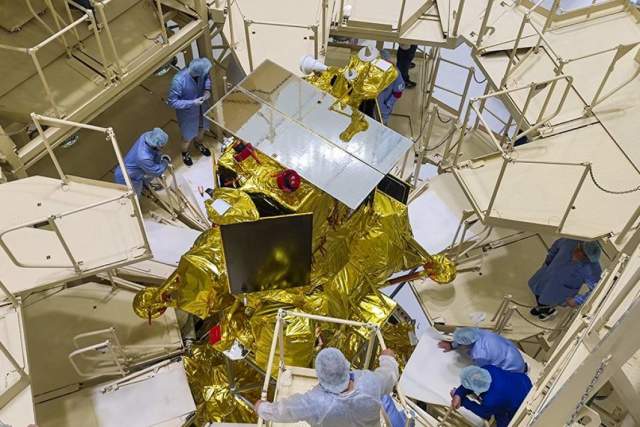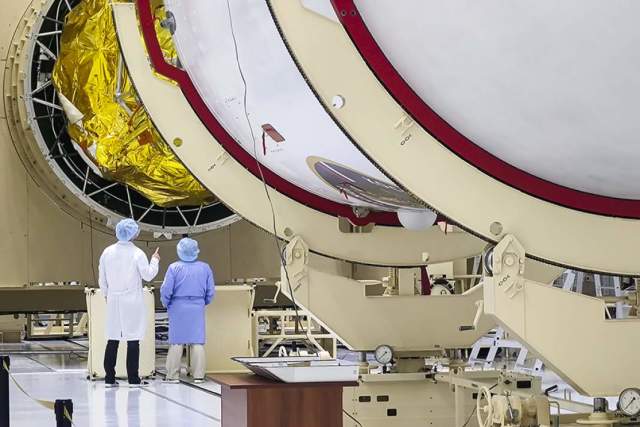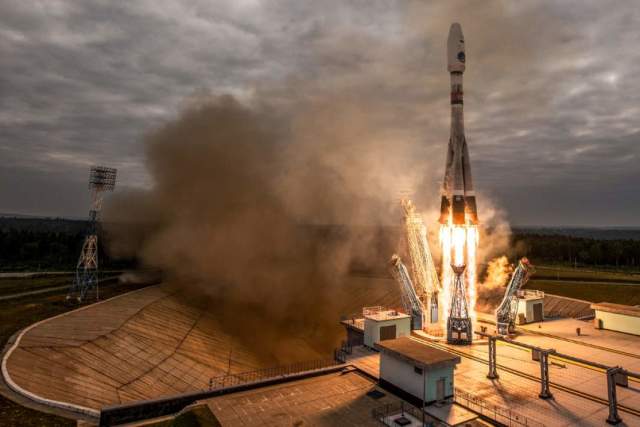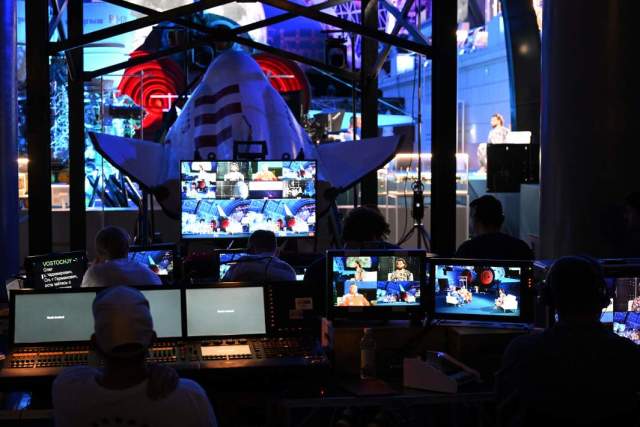What is the peculiarity of the automatic station "Luna-25" and what opportunities will open up to scientists
On the night of August 11, the Luna-25 automatic station successfully went to the Earth satellite. This is the first such flight in the history of modern Russia. Scientists associate a lot of expectations with the mission — in particular, based on the analysis of ice crystals contained in the regolith, it will be possible to understand whether there is a chance to build a habitable base on the Moon. However, to do this, the station must safely overcome the path from Earth and land on the surface near the lunar South Pole — it is for the last stage that experts worry the most. Russia last landed on the moon in 1976, when the technology was still analog, but now a more complex digital one is being used. However, experts say that the equipment has passed the maximum possible tests on Earth, and they hope for success.
On the road-the road
The Luna-25 automatic station was launched from the Vostochny cosmodrome on August 11 at 02:10 Moscow time. The Soyuz 2.1b carrier rocket launched the station into near-Earth orbit. For the first time in the history of modern Russia, a spacecraft went to an Earth satellite.
The rocket set off exactly at the appointed second, exactly according to the planned plan. After a short command "launch", the launch vehicle took off. Stable, stable, normal, there is — almost every phrase of the MCC that was broadcast live was accompanied by these words. For several minutes, against the background of complete silence, the comments "the pressure in the chambers of the launch vehicle is normal", "60 seconds - normal flight", "70 seconds — the parameters of the launch vehicle are normal", "there is a shutdown of the engines of the side blocks, there is a separation of the side blocks" were heard.

Employees of the installation and testing building of the Vostochny cosmodrome during the docking of the Luna-25 automatic station with the Fregat upper stage
Image Source: Photo: TASS/Roscosmos Media/Andrey Bely
9.5 minutes after the launch, the Fregat upper stage and the spacecraft were in the so-called closed reference orbit. At an altitude of about 200 km above the Earth, they spent about an hour, then the Frigate entered the flight path to the Moon.
Next, the station should move around the satellite for three days in a near—polar orbit with a height of 100 km - during this time it will make 36 turns. The next stage is a flight around the Moon in an elliptical landing orbit with a minimum altitude of 18 km and a maximum of 100 km. The spacecraft will spend two more days in this orbit, having completed 24 orbits.
Finally, if everything goes well, on August 21-22, the station will land near the lunar South Pole near the Boguslavsky crater. The declared active life of the probe on the surface of the Moon is at least one Earth year.

Rolling the fairing of the launch vehicle onto the head unit as part of the Luna-25 automatic station and the Fregat upper stage
Image Source: Photo: TASS/Roscosmos Media/Sergey Zakharushkin
— I am sure that our scientists, ballistics specialists, developers, designers and engineers have provided all possible technical solutions for the successful implementation of this difficult task. The successful flight of the Luna-25 station will open a new page in the development of the Earth's natural satellite," said Oleg Blinov, a test cosmonaut, head of the laboratory for the creation of complex simulators for his promising transport ships of the Gagarin Central Research and Development Center, a graduate student of MAI.
The Source of life
One of the main reasons for the increased interest in the Moon is the presence of water ice reserves there. Theoretically, it can become the main auxiliary resource for the development of the Earth's satellite. Most experts agree that it is possible to fully start working with the resources of a natural satellite only by building a habitable base there. The presence of water can partially solve the problem of the lack of food and fuel on the moon.
The second reason for the interest in the moon is rare earth metals that can be mined and brought to our planet. They are needed, in particular, for the production of electronics. On Earth, their reserves may come to an end within a few decades, given the increasing pace of technology consumption by mankind. Finally, the exploration of the Moon is considered as an important stage of preparation for expeditions to Mars.
The Soyuz-2.1B launch vehicle with the Luna-25 automatic station during its removal to the launch complex of the Vostochny Cosmodrome
Image Source: Photo: TASS/Roscosmos Media/Natalia Berezhnaya
As part of the current mission, the spacecraft must study the surface of the Moon, take a soil sample and analyze it. The orbital probe will allow you to select suitable sites for the following descent vehicles.
— In my opinion, every effort has been made to make the mission successful, — said Maxim Litvak, head of the Neutron and gamma Spectroscopy Laboratory of the Nuclear Planetology Department of the Space Research Institute of the Russian Academy of Sciences. — I myself have seen and can confirm that the area of work related to scientific equipment is done conscientiously. All kinds of tests were carried out both separately from the spacecraft and together with it. Of course, it is impossible to simulate exactly the same conditions as on the Moon, but experts tried to get as close to them as possible.
The scientific equipment of the lunar landing station consists of eight Russian instruments designed to study the composition, structure and physico—mechanical properties of the surface lunar regolith, study the near-surface dust and plasma exosphere.

Launch of the Soyuz-2.1b launch vehicle with the Luna-25 automatic space station from the Vostochny Cosmodrome
Image Source: Photo: TASS/Sergey Savostyanov
— The main difference between the Luna-25 mission and all the previous ones is that this is the first practically "polar" long—lived expedition, - Maxim Litvak said. — The manipulator will be able to take soil samples and put it into a device that will analyze its elemental composition. One of the most important and interesting questions is the distribution of water ice in the regolith in the polar regions of the Moon.
Come back and stay
Roscosmos considers the soft landing on the surface of the Moon to be the most difficult stage.
— Russia has not been on the moon for a very long time, — said Nathan Eismont, a leading researcher at the Space Research Institute of the Russian Academy of Sciences. — Let me remind you that Luna-24 was launched on August 9, 1976, and as a result, proof of the presence of water on the Earth's satellite was obtained. A logical question may arise here — if it worked before, why can difficulties arise now? The fact is that earlier analog technology was used for control, but today digital technology is used. The latter, of course, has much more features, but analog is much more reliable and simpler.
In 2023, the landing of the Japanese Hakuto-R module on the Moon ended in failure — communication with it was lost. Also, Israel's first Beresheet lander crashed while landing on an Earth satellite in 2019. Now India is literally competing with Russia in the race to the Moon, which launched its spacecraft to the South Pole on July 14. According to representatives of the Indian Space Research Organization, the lander will get there on August 23-24.

Broadcast of the launch of the Soyuz-2.1b carrier rocket with the Fregat upper stage and the Luna-25 automatic station from the Vostochny cosmodrome in the Cosmos pavilion at VDNH in Moscow
Image source: Photo: RIA Novosti/Maxim Blinov
— Based on the examples of other countries, it is the failure of technology that should be feared when landing, — concluded Nathan Eismont. — This is a really vulnerable place, for which I personally and, I think, many of my colleagues worry the most.
Earlier, the state corporation "Roscosmos" stated that the probability of a successful landing is about 80%.
— In fact, Luna-25 is an attempt from a technical point of view to repeat what was already done 47 years ago, — a source in Roscosmos told Izvestia.
According to the Roscosmos plan, the next missions are Luna—26 and Luna-27.
Olga Kolentsova

